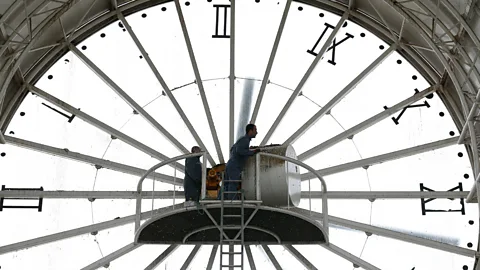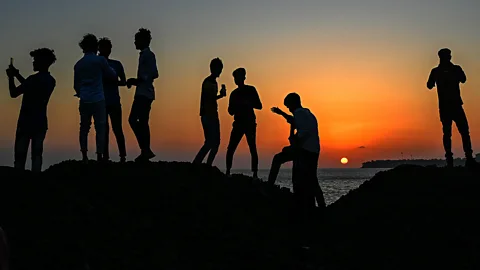Places around the world that opt out of daylight savings - and why
 Getty Images
Getty ImagesThe pros and cons of daylight saving sparks debate around the world. Here's why some places have opted out.
Over the last decade, countries and states around the world have abolished the practice of daylight saving time for various reasons, while other locations still cling to the practice despite health experts saying it is damaging.
Seasonal clock shifts involve "springing" the clock forwards one hour in the spring to be on daylight savings time and "falling" backwards one hour in autumn to be on standard time. According to a 2023 analysis by Pew Research Center, half of countries globally previously observed these clock changes. Now, only about one third maintain the custom.
The bulk of the United States, most of Europe, and parts of Canada, Australia, Latin America, Brazil and the Caribbean have remained holdouts and still adjust their clocks. But plenty of places around the world have opted out of it entirely. These include all of Asia, and most of Africa. Over the past 10 years, Azerbaijan, Iran, Jordan, Namibia, Russia, Samoa, Syria, Turkey, Uruguay and most of Mexico have all ended the practice, according to the Pew Research Center. In the United States, Hawaii and Arizona skip the practice, as do American Samoa, Guam, the Northern Mariana Islands, Puerto Rico and the US Virgin Islands.
In December 2024, Donald Trump indicated that he wanted to end daylight saving time in the US, describing it as "inconvenient" and "very costly", but when asked in March 2025 about the issue, the US president took a step back, saying it was a "50-50 issue".
But why do some people want to abolish daylight savings? Experts cite safety, health, and climate issues as reasons why daylight saving shifts should be abolished.
Jagdish Khubchandani, professor of public health at New Mexico State University, shares that some research has indicated a correlation between clock shifts and health problems ranging from sleep disruptions to heart attacks.
"Other studies and experts have also discussed accidents, mental health, well-being, etc," he adds. That said, "one could easily argue that these are short-term effects of transitions and more long-term studies are needed", he concludes.
Daylight saving shifts disrupt sleep-wake cycles
Time shifts, such as those related to daylight saving, disrupt circadian rhythms, also known as the sleep-wake cycle. Disruption has been shown to increase disease severity.
"The most important synchronizer of our circadian rhythms is the daylight, which helps all our body clocks to stay in sync," says Tord Wingren, an engineer who studies sleep and light exposure. Wingren does own a company that sells natural lighting alternatives; however, he is advocating for the change to abolish daylight saving time so that people would have access to natural morning light without these product aids.
Exposure to light in the morning cues one's circadian-rhythm. Tissues throughout the body have peripheral clocks that sync, based on these cues, to our master body clock in the brain. That master clock, in response to light exposure via the eyes, is responsible for kicking off a cascade of hormonal processes. The hormones affected include those related to stress, blood sugar management, and hunger and satisfaction signalling.
"Clock shifting can deprive working individuals [and] school-going populations from this boost, as they may have to start their day in darker times," Khubchandani says.
Exposure to darkness is a good thing at night, when it helps the body produce melatonin, a hormone that prepares the body for sleep. But thanks to clock shifts, "the extra light during evenings may delay our sleeping times [and] routines", Khubchandani explains.
Researchers from the American Academy of Sleep Medicine wrote a 2020 position statement in the Journal of Clinical Sleep Medicine noting that springing forwards is indeed harmful.
The AASP researchers use "social jet lag" as a term to describe the chronic misalignment between one's natural sleep-wake cycle and life's demands from work, school and family, noting that daylight saving directly causes that social jet lag. It can be even worse in the western-most areas of a time zone. Social jet lag is associated with obesity, metabolic syndrome, cardiovascular disease, and depression.
"It is, therefore, the position of the American Academy of Sleep Medicine that these seasonal time changes should be abolished in favour of a fixed, national, year-round standard time," the researchers write.
 Getty Images
Getty ImagesSafety concerns with daylight saving
Daylight savings time practices have been linked to increases in deadly traffic accidents, workplace injuries, medical errors and overall mortality.
In 2018, researchers in Spain penned a letter that was published in the journal Epidemiology regarding a link between deadly car accidents and daylight savings shifts. After collecting data from cities in Spain between 1990 and 2014, the researchers found a 30% increase in fatal traffic accidents on the day clocks sprang forwards. On the day clocks fell backwards, they saw an increase of 16%.
An older study from 2009, published in the Journal of Applied Psychology used data from the US Bureau of Labor Statistics to see if daylight saving was associated with more workplace injuries. They found a nearly 6% increase in injuries on the Monday after clocks sprang forward.
In a 2021 observational study, researchers from the Mayo Clinic in the United States looked at whether daylight saving time increased the risk of medical errors. They examined data from voluntarily reported safety-related incidents from facilities in the United States occurring from 2010 to 2017. They then refined the data by looking at instances likely stemming from human error that occurred in the week prior to and the week after daylight savings clock shifts.
Health concerns with daylight saving
One of the serious health concerns related to time shifts is acute myocardial infarction, or heart attack. Researchers in Italy wrote a 2018 review published in the journal Internal Emergency Medicine investigating daylight savings' potential effects on heart health. They reviewed seven existing studies from the United States and Europe looking at more than 80,000 cases of acute myocardial infarction. They found an increase, from 4% to 29%, in heart attacks after clocks sprang forwards.
Incidence of stroke may also increase after a clock shift. For a 2016 study published in the journal Sleep Medicine, researchers in Finland investigated the connection. They analysed more than 3,000 hospitalizations from 2004 to 2013 that occurred in the week following seasonal clock changes. They next compared those cases to a control group of 11,000 expected hospitalizations. The findings showed that hospitalizations for ischaemic stroke, the most common type, increased by 8% in the two days following a daylight savings shift. When looking at the whole week post-shift, the increase was 3%. The association was stronger for people assigned female at birth and those who were older.
"[Daylight savings] can potentially influence one's cardiovascular health as well as contribute to mood disturbances and disruption of cognitive performance," says Nesochi Okeke-Igbokwe, an internist in private practice.
For a 2017 study published in the journal Epidemiology, researchers used records from the Danish Psychiatric Central Research Register. They analysed nearly 200,000 hospital contacts for unipolar depression from 1995 to 2012. The findings showed an 11% increase in unipolar depressive episodes after the spring clock shift. The increase dissipated over the 10 weeks following the clock change.
 Getty Images
Getty ImagesEnergy use and daylight saving
Although implementation dates for countries varied, the first discussions on implementation of daylight saving occurred in 1916. However, Benjamin Franklin is credited with the original concept after analysing candle consumption in 1784 and suggesting people alter their overall sleep schedules to save money on lighting costs.
US National Archives attribute Germany as having the earliest experience with daylight saving during World War One. Reasons for implementation involved saving on energy bills, having more daylight in the evening for leisure time, and more.
The state of Arizona, on the other hand, opted out of daylight savings shifts in order to save energy. It is one of the few US states that does not participate in daylight saving practices. According to Arizona State University, the state implemented daylight saving in 1967 and abolished it that same year (however, the Navajo Nation within Arizona still participates) because Arizonans found that the clock change caused a surge in energy consumption. The desert state is notably hot, and people had to run their air conditioners for longer into the evening, driving energy use and costs. As the globe heats up due to climate change, more states, provinces and countries may follow suit.
The future of daylight saving
In 2018, the European Commission proposed an end to clock shifts. However, the European Council has not agreed on its position. The European Parliament voted in favour of adopting the change. However the Council and Parliament must reach an agreement for the change to occur.
"Unfortunately, it seems Sweden [is] waiting on unity within EU before acting," says Wingren, who resides in the country. "There was news two to three years ago about that Sweden should stop using DST, but this was never implemented.”
In a different take, Florida Senator Marco Rubio introduced the Sunshine Protection Act in March 2023. If passed, the bill would make daylight saving times permanent in the United States, but the proposed legislation, after passing in the Senate, has stalled in the House of Representatives.
If passed in the future, the bill would mean the US would spring clocks forwards a final time and not fall back six months later. However, the delay of sunlight in the morning and the extended sunlight in the evening has health experts, such as Khubchandani, concerned.
"We need natural light to start our days well, with more alertness, and brighter mood (via secretion of hormones and neurotransmitters," he says.
That’s why the American Academy of Sleep Medicine advocates for the opposite. "Current evidence best supports the adoption of year-round standard time, which aligns best with human circadian biology and provides distinct benefits for public health and safety," the organisation wrote in response to the bill.
What do global populations want regarding daylight saving?
Another consideration regarding time shifts is what the public thinks about the practice.
"Public health is of the people and for the people," Khubchandani explains. "So there is a public perception related to preferences. There are not too many polls across the nation that support the practice of DST/shifting clocks."
In a Monmouth University Poll, researchers found that just about two-thirds of people in the US would prefer to nix the practice of seasonal time shifts.
A governmental survey from British Columbia, Canada, found that 93% of respondents want to end the shifts and stay on daylight savings time permanently. The European Commission conducted a survey in 2018, and 84% of respondents were in favour of ending daylight saving time. And a YouGov survey in the UK found that 44% of Britons want to continue with it.
* This article was originaly pubished on 08 March 2024 and was updated on 6 March 2025 to include details of Donald Trump's position.
--
If you liked this story, sign up for The Essential List newsletter – a handpicked selection of features, videos and can't-miss news delivered to your inbox every Friday.
